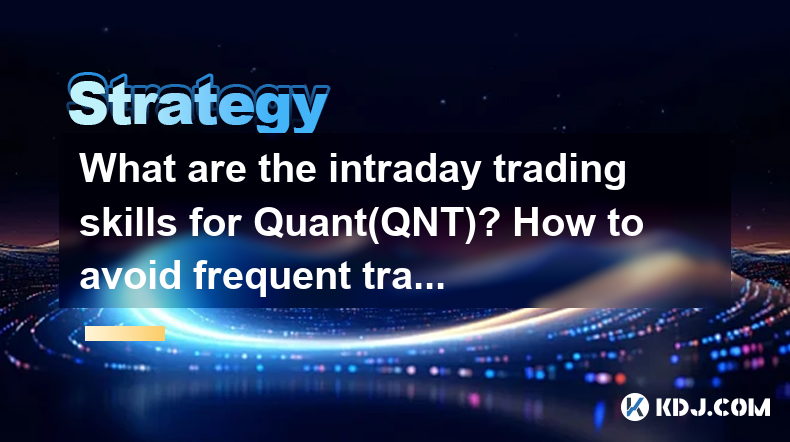-
 bitcoin
bitcoin $121833.232455 USD
-0.63% -
 ethereum
ethereum $4394.437030 USD
-2.00% -
 tether
tether $1.000570 USD
0.04% -
 bnb
bnb $1255.553465 USD
-3.73% -
 xrp
xrp $2.814944 USD
-1.59% -
 solana
solana $221.835346 USD
-2.40% -
 usd-coin
usd-coin $0.999869 USD
0.01% -
 dogecoin
dogecoin $0.249495 USD
-1.32% -
 tron
tron $0.336905 USD
-1.24% -
 cardano
cardano $0.816464 USD
-1.69% -
 chainlink
chainlink $22.130946 USD
-1.27% -
 hyperliquid
hyperliquid $44.208522 USD
-3.46% -
 ethena-usde
ethena-usde $1.000521 USD
0.02% -
 sui
sui $3.422897 USD
-2.51% -
 stellar
stellar $0.380164 USD
-1.31%
What are the intraday trading skills for Quant(QNT)? How to avoid frequent trading losses?
Mastering intraday trading of Quant (QNT) requires technical analysis, risk management, and understanding market sentiment to minimize losses and maximize profits.
May 01, 2025 at 08:15 am

Introduction to Intraday Trading with Quant (QNT)
Intraday trading, also known as day trading, involves buying and selling assets within the same trading day. For traders interested in Quant (QNT), a cryptocurrency focused on the interoperability of blockchains, mastering intraday trading skills is crucial. This article will delve into the essential skills required for successful intraday trading of QNT and provide strategies to minimize frequent trading losses.
Understanding Quant (QNT) and Its Market Dynamics
Before diving into trading strategies, it's important to understand Quant (QNT). QNT is the native token of the Quant Network, which aims to connect blockchains and networks on a global scale. The value of QNT is influenced by various factors, including market sentiment, technological developments, and broader cryptocurrency market trends. Keeping an eye on these factors can help traders make informed decisions during intraday trading sessions.
Key Intraday Trading Skills for Quant (QNT)
Technical Analysis
Technical analysis is a cornerstone of intraday trading. For QNT, traders should focus on understanding and using various technical indicators to predict price movements. Key indicators include:
- Moving Averages: These help smooth out price data to identify trends over specific periods. For QNT, using a combination of short-term and long-term moving averages can signal potential buy or sell points.
- Relative Strength Index (RSI): This momentum oscillator measures the speed and change of price movements. An RSI above 70 might indicate that QNT is overbought, while an RSI below 30 suggests it is oversold.
- Bollinger Bands: These bands help traders identify volatility and potential price breakouts. When the price of QNT touches the upper Bollinger Band, it might be a signal to sell, and when it touches the lower band, it could be a signal to buy.
Risk Management
Effective risk management is crucial to avoid frequent trading losses. Traders should:
- Set Stop-Loss Orders: These orders automatically sell QNT when it reaches a predetermined price, limiting potential losses. For example, if you buy QNT at $100, setting a stop-loss at $95 can protect you from significant downturns.
- Position Sizing: Determine the amount of QNT to trade based on your total capital. A common rule is to risk no more than 1-2% of your trading capital on a single trade.
- Diversification: While focusing on QNT, consider diversifying your portfolio with other cryptocurrencies to spread risk.
Market Sentiment Analysis
Market sentiment plays a significant role in the price movements of QNT. Traders should:
- Monitor Social Media and News: Platforms like Twitter, Reddit, and cryptocurrency news sites can provide insights into the current sentiment around QNT. Positive news or developments can lead to price surges, while negative news can cause declines.
- Sentiment Analysis Tools: Utilize tools that analyze social media data to gauge the overall sentiment towards QNT. This can help in making timely trading decisions.
Speed and Timing
Intraday trading requires quick decision-making and precise timing. For QNT, traders should:
- Use Real-Time Data: Access to real-time price data and market updates is essential. Many trading platforms offer real-time charts and data feeds that can help traders react quickly to market changes.
- Practice with Simulated Trading: Before trading QNT with real money, practice with a simulated trading environment. This can help improve your timing and decision-making skills without financial risk.
Strategies to Avoid Frequent Trading Losses
Develop a Trading Plan
A well-defined trading plan is essential for avoiding frequent losses. Your plan should include:
- Entry and Exit Points: Clearly define the price levels at which you will enter and exit trades. For QNT, this might involve setting specific price targets based on your technical analysis.
- Trading Goals: Set realistic profit targets and loss limits. This helps maintain discipline and prevents emotional trading decisions.
- Review and Adjust: Regularly review your trading plan and adjust it based on your performance and market conditions.
Avoid Emotional Trading
Emotional trading is a common pitfall that can lead to frequent losses. To mitigate this:
- Stick to Your Plan: Adhere to your trading plan even when emotions run high. Avoid making impulsive decisions based on fear or greed.
- Take Breaks: If you find yourself becoming emotionally attached to a trade, take a break. Step away from the screen and return when you are calm and rational.
- Keep a Trading Journal: Document your trades, including your emotions and thought processes. This can help identify patterns in your trading behavior and improve your decision-making.
Utilize Trading Tools and Platforms
Trading tools and platforms can enhance your trading efficiency and help avoid losses. Consider using:
- Automated Trading Bots: These can execute trades based on predefined criteria, reducing the impact of emotional decision-making. For QNT, bots can be programmed to buy or sell at specific price points or when certain technical indicators are triggered.
- Advanced Charting Software: Use software that offers advanced charting capabilities and customizable indicators. This can provide deeper insights into QNT's price movements and help you make more informed trading decisions.
- Risk Management Tools: Many platforms offer tools to manage risk, such as trailing stops and guaranteed stop-loss orders. These can protect your capital and limit losses on QNT trades.
Frequently Asked Questions
What are the common mistakes to avoid when intraday trading QNT?
Common mistakes include overtrading, ignoring risk management, and letting emotions drive trading decisions. Overtrading can lead to exhaustion and poor decision-making, while ignoring risk management can result in significant losses. Emotional trading, driven by fear or greed, often leads to irrational decisions that can harm your trading performance.
How can I improve my technical analysis skills for trading QNT?
Improving your technical analysis skills involves continuous learning and practice. Start by studying various technical indicators and their applications. Use demo accounts to practice analyzing QNT's price charts and making trades based on your analysis. Additionally, consider joining trading communities or forums where you can learn from experienced traders and discuss strategies.
Is it possible to trade QNT profitably without using leverage?
Yes, it is possible to trade QNT profitably without using leverage. Trading without leverage reduces risk and can lead to more sustainable profits over time. Focus on developing a solid trading strategy, managing risk effectively, and making well-informed trading decisions based on thorough analysis.
What role does liquidity play in intraday trading of QNT?
Liquidity is crucial for intraday trading as it affects the ease with which you can buy and sell QNT. High liquidity means you can execute trades quickly and at desired prices, reducing the risk of slippage. Monitor the trading volume and order book depth of QNT to gauge its liquidity and plan your trades accordingly.
Disclaimer:info@kdj.com
The information provided is not trading advice. kdj.com does not assume any responsibility for any investments made based on the information provided in this article. Cryptocurrencies are highly volatile and it is highly recommended that you invest with caution after thorough research!
If you believe that the content used on this website infringes your copyright, please contact us immediately (info@kdj.com) and we will delete it promptly.
- Morpho Crypto: Rebuilding Ethereum Lending in the DeFi Landscape
- 2025-10-10 14:45:14
- TT Jagannathan: The Prestige Founder Who Revolutionized Indian Kitchens
- 2025-10-10 12:25:15
- Bitcoin's Open Interest Dip: What's the Deal?
- 2025-10-10 12:25:15
- Dogecoin, Litecoin, and BlockDAG: Crypto's Old Guard Meets the New Kid
- 2025-10-10 12:30:02
- MOBU BTC: Why MoonBull Could Be Your Next Crypto Obsession
- 2025-10-10 12:45:14
- Coinbase, Staking, and the Crypto Scene: A New York State of Mind
- 2025-10-10 12:30:02
Related knowledge

Practical parameter settings for a Bitcoin multi-timeframe moving average system
Sep 18,2025 at 10:54pm
Optimizing Timeframe Combinations for Bitcoin Trading1. Selecting appropriate timeframes is crucial when building a multi-timeframe moving average sys...

How can I filter out false breakouts in Dogecoin high-frequency trading?
Sep 22,2025 at 01:00am
Understanding False Breakouts in Dogecoin Trading1. A false breakout occurs when Dogecoin's price appears to move beyond a defined support or resistan...

Techniques for identifying tops and bottoms in the Bitcoin on-chain NVT model
Sep 20,2025 at 07:54pm
Understanding the NVT Model in Bitcoin Analysis1. The Network Value to Transactions (NVT) ratio is often described as the 'P/E ratio' of the cryptocur...

What does the surge in open interest in Bitcoincoin futures mean?
Sep 20,2025 at 11:18pm
Understanding the Surge in Dogecoin Futures Open Interest1. A surge in open interest within Dogecoin futures indicates a growing number of active cont...

How can I use the Ethereum USDT premium to gauge market sentiment?
Sep 18,2025 at 11:55pm
Understanding the Ethereum USDT Premium1. The Ethereum USDT premium refers to the price difference between USDT (Tether) traded on Ethereum-based plat...

What should I do if Ethereum staking yields decline?
Sep 20,2025 at 06:18am
Understanding the Causes Behind Declining Ethereum Staking Yields1. The Ethereum network transitioned to a proof-of-stake consensus mechanism with the...

Practical parameter settings for a Bitcoin multi-timeframe moving average system
Sep 18,2025 at 10:54pm
Optimizing Timeframe Combinations for Bitcoin Trading1. Selecting appropriate timeframes is crucial when building a multi-timeframe moving average sys...

How can I filter out false breakouts in Dogecoin high-frequency trading?
Sep 22,2025 at 01:00am
Understanding False Breakouts in Dogecoin Trading1. A false breakout occurs when Dogecoin's price appears to move beyond a defined support or resistan...

Techniques for identifying tops and bottoms in the Bitcoin on-chain NVT model
Sep 20,2025 at 07:54pm
Understanding the NVT Model in Bitcoin Analysis1. The Network Value to Transactions (NVT) ratio is often described as the 'P/E ratio' of the cryptocur...

What does the surge in open interest in Bitcoincoin futures mean?
Sep 20,2025 at 11:18pm
Understanding the Surge in Dogecoin Futures Open Interest1. A surge in open interest within Dogecoin futures indicates a growing number of active cont...

How can I use the Ethereum USDT premium to gauge market sentiment?
Sep 18,2025 at 11:55pm
Understanding the Ethereum USDT Premium1. The Ethereum USDT premium refers to the price difference between USDT (Tether) traded on Ethereum-based plat...

What should I do if Ethereum staking yields decline?
Sep 20,2025 at 06:18am
Understanding the Causes Behind Declining Ethereum Staking Yields1. The Ethereum network transitioned to a proof-of-stake consensus mechanism with the...
See all articles

























![Web3 Crypto Market Morning Report: Fomo on the Bnb chain continues, Binance launches the chain-sweeping platform Meme Rush, the market value of Xiuxian exceeds 40 million U.S. dollars, OK Binance business war begins [Vic TALK Issue 1437] Web3 Crypto Market Morning Report: Fomo on the Bnb chain continues, Binance launches the chain-sweeping platform Meme Rush, the market value of Xiuxian exceeds 40 million U.S. dollars, OK Binance business war begins [Vic TALK Issue 1437]](/uploads/2025/10/10/cryptocurrencies-news/videos/web-crypto-market-morning-report-fomo-bnb-chain-continues-binance-launches-chainsweeping-platform-meme-rush-market-xiuxian-exceeds-dollars-binance-business-war-vic-talk-issue/68e861c5dbd1c_image_500_375.webp)
















































